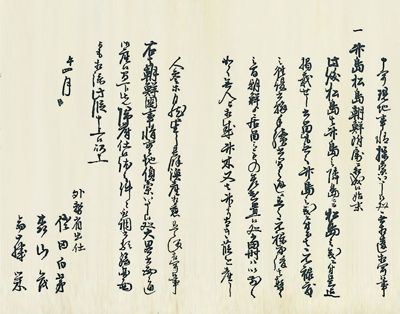- Dokdo in the East Sea
- Educational material
- Junior High School Version
Dokdo in the East Sea
Table of Contents Open Contents
- Dokdo: Korean Territory
- Dokdo: Keeper of the East Sea!
- Ulleungdo and Dokdo: We’re Siblings!
- Dokdo’s Been Korean Land Since the Three Kingdoms Period!
- Dokdo’s Been Korean Land in the Modern Era!
- Dokdo Appears Even on Old Maps!
- Mission: Protect Dokdo!
- Others Have Known, Too ... That Dokdo Is Korean Land!
- Dokdo Is Korean Land Even on Old Japanese Maps!
- Japan’s Claims to Dokdo Are False!
Discovery Learning 2[Teacher Notes]
-
- Figure 1 『Onshu Survey Records Compilation』
-
Japan’s first records about Ulleungdo and Dokdo appeared in Records on Observations on Oki, which was compiled in 1667.
This document was the record of a Japanese administrator who had received instructions from an official to inspect the Oki Islands.
“Songdo (Dokdo) and Jukdo (Ulleungdo) are located northwest of the Oki Islands. Looking at Goryeo from these two islands is similar to looking at the Oki Islands from Onshū. Therefore, the western boundary of Japan is determined to be the Oki Islands.” The Korean sovereignty of Dokdo and Ulleungdo was clearly acknowledged.
-
- Figure 2 Daijo-kan Order
-
In 1876, the Meiji government ordered each of Japan’s prefectures to submit maps to create a complete map of Japan. At this time, an inquiry was made by the local government of Shimane Prefecture to the Meiji government on whether to include Ulleungdo and Dokdo located in the East Sea.
After five months of research, Japan’s Minister of Home Affairs decided that Ulleungdo and Dokdo were Joseon territory and therefore irrelevant to Japan. The Daijōkan, the highest administrative office of the Meiji government, informed Shimane Prefecture through the Ministry of Home Affairs in 1877, “Ulleungdo and Dokdo have no relation with Japan, and you must keep that in mind.”
-
• Daijo-kan
Established in 1868, the Daijōkan was the highest administrative office in Japan’s Imperial government until the cabinet system was introduced in 1885. It controlled the country’s legislative, administrative, and judicial branches.
• Meiji Restoration
In 1868, domainal lords in Japan succeeded in overthrowing the Edo shogunate, which resulted in the Meiji Restoration. This event restored absolute imperial rule to a newly-unified Japan and brought major changes to Japan’s political and social structure.
-
- Figure 3: “Chōsen-koku kōsai shimatsu naitansho” (Confidential Inquiry into the Particulars of Korea’s Relations with Japan,1870)(朝鮮國交際始末內探書)』
-
Japan’s new ambitions toward Korean territory began after the Meiji Restoration in 1868, when the Meiji government was founded. The government had ambitions of invading Joseon, and through the Ministry of Foreign Affairs began to spy on Joseon’s internal affairs. In December 1869, the Ministry of Foreign Affairs sent a three-man survey committee to Joseon.
One of the tasks of the survey committee was to investigate the situation of Takeshima and Matsushima.
Upon completion, the survey committee presented a report entitled “Chōsen-koku kōsai shimatsu naitansho.” Included in this report is information which indicates that Takeshima and Matsushima were Korean territory. This report confirms that Japan’s Ministry of Foreign Affairs and the Daijōkan were well aware of Ulleungdo and Joseon’s sovereignty over Dokdo.
-
- Figure 4: Documents Related to the Ulleungdo Border Dispute: Takeshima Chronicle
-
The Ulleungdo border dispute began in 1693 with the capture of An Yong-bok and Park Eo-dun by fishermen of the Oya and Murakawa families. The incident sparked a dispute between Joseon and Japan that involved fishing rights and the sovereignty of Ulleungdo. The “Ulleungdo Border Dispute Documents” contain information that Japan’s Edo shogunate recognized Ulleungdo and Dokdo as a set.
At the time, the shogunate acknowledged Ulleungdo to be Joseon territory and issued a prohibition against crossing the border and visiting Takeshima (Ulleungdo). The basis for this prohibition was the “distance” from Ulleungdo to Joseon and Japan. This was “because Takeshima (Ulleungdo) is close to Joseon and considerably far from Hoki.” Dokdo, which is close to Ulleungdo, was in turn acknowledged to be Joseon territory.
-
• Hoki: Formerly Matsue domain; today, Tottori Prefecture
-
- Discovery Learning 2
-
1. Arrange the information above in chronological order.[Answer]
-
2. Read Figure 1 and find out which came first between Korean and Japanese historical documents.[Answer]
-
3. Find out what prompted the compilation of the “Chōsen-koku kōsai shimatsu naitansho” (“Confidential Inquiry into the Particulars of Korea’s Relations with Japan,” 1870)[Answer]
Teacher Notes
Beginning with Japan’s first record about Ulleungdo and Dokdo, important historical sources regarding the islands are listed chronologically. Explain how Japan learned of the existence of Ulleungdo and Dokdo much later than Korea, and whether Japan knew the jurisdiction to which the islands belonged. Discuss Japan’s continuous attempts to invade the islands and Korea’s reactions to those incidents.
Explain Japan’s preparations for the invasion of not only Ulleungdo and Dokdo, but of Joseon, as well, after the Meiji Restoration as described in the Japanese text “Chōsen-koku kōsai shimatsu naitansho” (Confidential Inquiry into the Particulars of Korea’s Relations with Japan) of 1870.
Explain Japan’s preparations for the invasion of not only Ulleungdo and Dokdo, but of Joseon, as well, after the Meiji Restoration as described in the Japanese text “Chōsen-koku kōsai shimatsu naitansho” (Confidential Inquiry into the Particulars of Korea’s Relations with Japan) of 1870.
닫기
Answer
1. | Figure 1 | → | Figure 4 | → | Figure 3 | → | Figure 2 |
닫기
Answer
2. The earliest Korean document is History of the Three Kingdoms, which was written 522 years prior to the earliest Japanese document, Records on Observations on Oki.
닫기
Answer
3. For the invasion of Joseon
닫기















